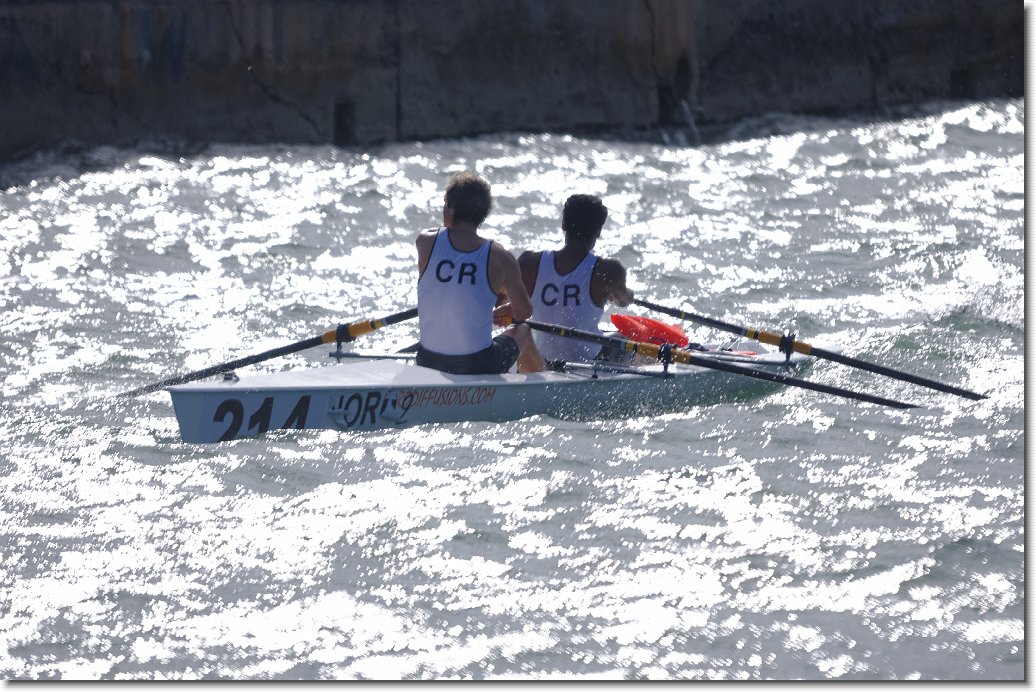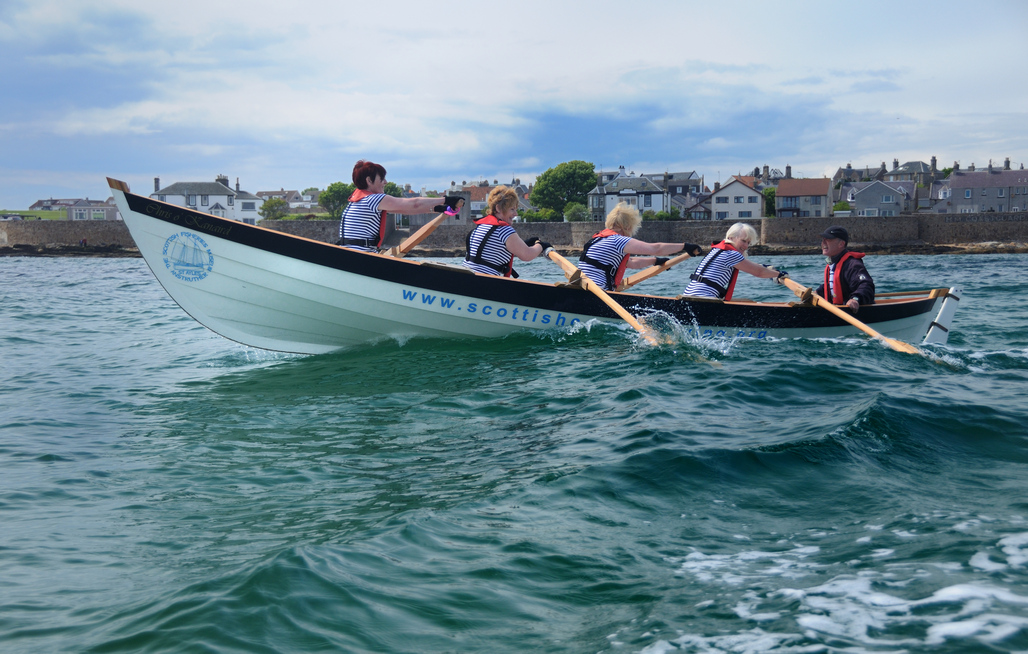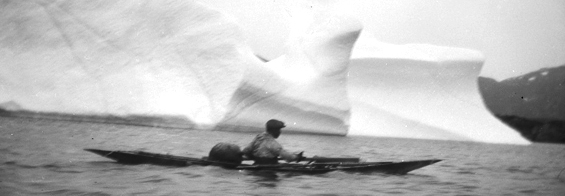Sagar Sen, rower from Norway who participated at the 2014 world coastal rowing championships in Thessaloniki, Greece, gives an introduction to coastal rowing.
In the summer of 2006, during my first séjour in France, my friend Nicolas Parquic asked me, “Sagar you want to go to Brest to row on ze sea for ze Championnats de Bretagne? Zere will be waves and it will be interesting to adapt to zem!”. Not knowing what to say right away I plunged into a “oui mais..” moment of light-heartedness.
I had rowed only on water that was flat like a mirror or in a slightly choppy St. Catherines river back in Canada. Rowing a sixty-five kilogram boat (almost thrice the weight of a normal rowing double) on the relatively big waves of the Atlantic ocean was quite out of the comfort zone I knew.

We agreed to do it and drove from Rennes to Brest in northwest France carrying the oars of Rennes étudiant club. Nicolas and myself paddled into the ocean in a borrowed Eurodiffusions coastal rowing double along with the other teams.
A coastal rowing race is around a circuit of three or four large buoys derived from the format of sailing races. I didn’t think much about all that and let Nicolas (sitting behind me) take charge of placing ourselves on the start line and eventually ensure that we were going the right way. Nicolas said, “Lets place ourselves next to zeese guys from Concarneau, zose guys are fast”. The race started with the long sound of an air horn and an instant later I could hear phu phu phu..sounds of breathing out all around me. The race was frantic and the start as we headed for the first buoy almost all together. If I remember correctly we avoided crashes except hitting the buoy on the right side. Boats then slowly spread out over a grueling twelve kilometer (today the races are six kilometers long) race. Nicolas nicely managed navigating the boat and kept pushing me to surf and row light..”léger Sagar léger” he said. The meaning of these words dawned on me a few days later. That's when began my love for the sport; the art of surfing, slicing and dicing through the waves of the humbling sea.
What is coastal rowing?
Before we delve into what coastal rowing is it is worthwhile to get an overview of rowing itself.
Rowing: Rowing is a water sport where you principally use your legs, back, and arms to propel a boat on the surface of water, essentially trying to make it glide by creating air bubbles under the boat.
When you row with one oar and hopefully with at least one other person then its called sweeping. While if you row with two oars, one in each hand then this mode of moving the boat is called sculling. You can either go out alone sculling in a single scull/sweep or with one, three, or seven other people in a longer boat. There will be times when you would need a leader called the coxswain to steer the boat and bring cohesion among rowers.
To me, the most gratifying part about rowing is the meditative state it puts you into. Imagine putting your blade in the water and taking a stroke and watching the landscape go by without much sound except that of the air bubbles trapped under your boat. This is the feeling that drives most people back on their boats.
Coastal Rowing: In coastal rowing you row with the geste that constantly adapts to elements called wind, waves, and currents trying to get from point A to B to C to D and back to A along with other boats trying to do the same in the open sea.

Occasionally, you are bumped into by either another boat, a buoy or a dolphin. Extreme adaptivity, a good sense of orientation and a heightened state of awareness are the hallmarks of coastal rowing. Peter Berg, a 2014 world champion in coastal rowing simply put it like this, “Olympic rowing on flat-water is like road biking while coastal rowing on the sea is like mountain biking”.
Waves and winds: In the open sea, winds come from any direction leading to the creation of surface waves. These waves are trochoidal waves. They have a circular motion. If you have ever been scuba diving, you will note that trochoidal waves give the feeling of being pushed back and forth underwater. Rowers must put their blades in the water at the right moment to get on the forward and deep face of a wave. This leads to surfing and the boat travels at the speed of the wave which is often faster than other boats that don’t catch the swell at the right moment. Waves can hit a boat transversally often breaking a nice rhythm.

Being a little stubborn and getting back in the game to keep the boat moving is the “joy” of coastal rowing. Depending on the height of the wave rowers often adjust their oar locks and bring them high enough to avoid getting the oar stuck in a big wave as seen in the figure with the coastal double.
Winds on an open sea turn oar blades on the boat to little sails. The blades are often pushed around by the wind leading to many errors in the rowing stroke that only add up on inches lost. A rower adorned with good blade work will try to create least resistance to the wind. A smart rower checks the wind and wave forecast on Wind Guru. Of course, some prefer to lick the finger and stick it out in the wind, but I keep that as a last option.
Waves can put the boat on an uneven water surface hence it is important to have different hand heights on the oars to be good grip of the water. Developing such a rowing style is a key point of difference between flat water and coastal rowing.
When I lived in France we often went to St. Malo on the coast of the Atlantic ocean. The Atlantic ocean has tidal waves that creates swells different from usual wind waves. These waves represent the feelings of a heartbroken lover trying to reach the moon but never makes it there. Rowing on them gives a surge in your own palpitating heart.
Currents: Currents in the sea can make a big difference in the speed of the boat and its direction. Ideally, it is always a good idea to learn about the currents in the coast from locals. Currents can be longshore currents, rip currents, gulf currents, upwellings and downwellings to name a few. Given an initial itinerary based on shortest paths between points it is often very useful (and safe) to redraw an itinerary based on the currents in the sea. Sometimes a long path may be faster due to the possibility of using currents between two points A and B via a third point C.
In 2011, Loïc Gérald my doubles partner and myself were racing on the basin of Basse-Indre close to the city of Nantes. We placed ourselves in the middle of the basin while the rest of the boats were sticking to the coast line. We wondered why everyone was sticking to each other on the coast and increasing their chances of collisions.
As soon as the race started it felt like we were rowing in mud instead of water. We were stuck in the middle of a current like duct tape. Those on the coast effortlessly went past us after hundred meters in the race and we couldn’t do much about it except not make the same mistake on the second lap but it was a bit too late.
The current is often strongest in the middle and least on the shores. However, without a current it is always advisable to row in deeper waters than in shallow waters. As boat speed increases in shallow water there is increased drag. That day onwards I made it point to make friends with the locals and listen to a captain’s meeting at a race and rely less only on my physical strength to wade through anything. Information begets fairness in coastal rowing.
Boats: Coastal rowing boats are designed to be resilient in choppy, windy, and wavy conditions. For instance, “ideally” the front doesn’t dive down into waves, can self-evacuate water because of an incline and open back, and can slice through and surf on waves. Oars are rigged higher than usual when the waves get bigger (greater than 1 meter). Most coastal boats must follow the regulations set by the international rowing federation FISA before a race. There are a number of boat manufacturers catering to different price ranges and with varying levels of performance in different conditions. Here is a list of well-known boat manufacturers: Leo coastal, Filippi, Salani Safran, and Eurodiffusions.
History of coastal rowing
History is a good place to start because when beliefs are deep-rooted it generates emotions that can make mountains move.
I started to blow the dust off Norwegian history books to get glimpses of what could strike a chord in the heart of every Norwegian about their lifestyle before they found oil in the 1960s. These glimpses are unshakeable stanchions in the potential of the human spirit.
Christopher Columbus himself was preceded five hundred years ago by Leif Eriksson, a Norwegian viking, who crossed the Atlantic rowing with a crew of thirty-five men. Frank Samuelson and George Harbo, Norwegian-born Americans, were the first ever to cross the Atlantic rowing in a double.
Survival in Norway (before the 1960s) depended on their great resilience and hunting skills in the cold north. Fridtjof Nansen, one of the greatest Norwegian explorers, donated his personal inuit kayak with seal fur hull to the student rowing club in Oslo, Norsk Studenters Roklub. He hunted seals and walruses for dinner.

In the consumption oriented world we live in today, rowing and fishing is done for recreation and not survival that much.
An anecdote from my life, not directly related to rowing, that I would always cherish was when I travelled to the Amazonas in Manaus, Brazil. The native guide and his assistant could spot a sloth or an iguana hundred meters away in the thick canopy of a tree with their naked eyes. While, we never managed to do so on several occasions even with binoculars. What was it about them that made them so sharp in their natural context? This question resonated in me and was one of the most humbling experiences I have ever had.
Working out in a closed gym gives an athletic contour, however, we will cease to develop skills of adaptation, orientation, and survival that one would while embracing natural elements in coastal rowing.
Sagar Sen is a research scientist residing in Oslo, Norway. Living in India, Canada, France and now Norway has continually shaped him as an academic, sportsman, and a compassionate world citizen. He feels an intimate relationship with water and has been rowing for over ten years now (both on flatwater and the sea).














